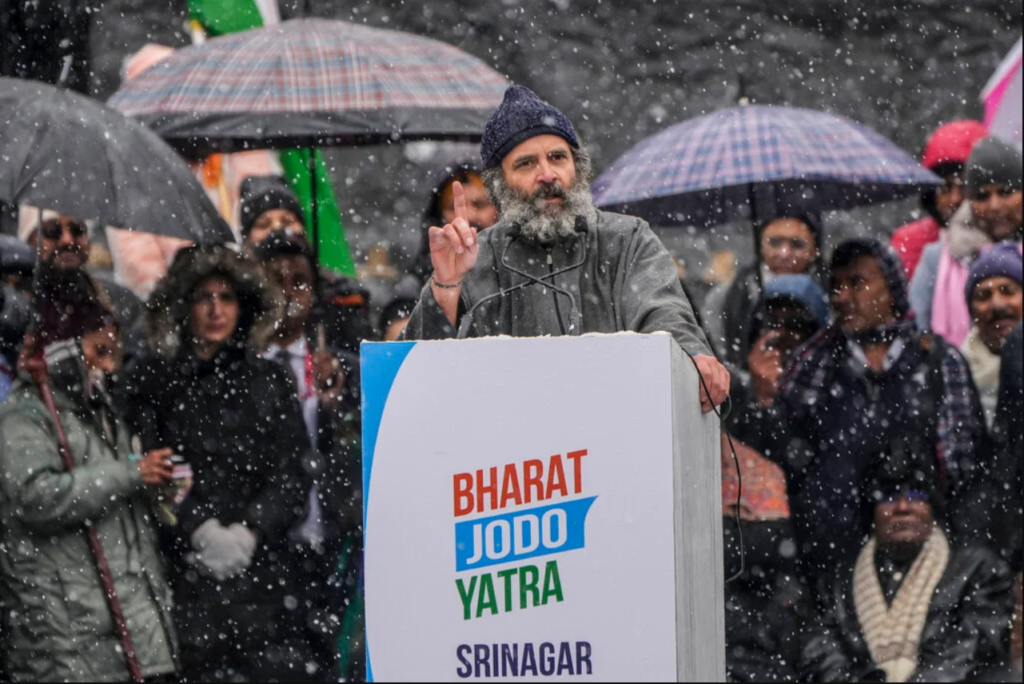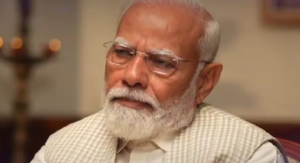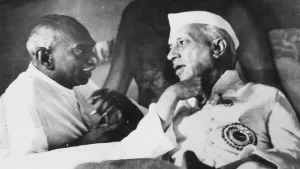From the Editor’s desk
Nafrat Chodo, Bharat Jodo
As we write this, the 3500 km long Bharat Jodo Yatra (BJY) is nearing its end. After passing through 12 states and two union territories, the yatra will conclude in Srinagar on January 30 — the 150th day of the Yatra — coinciding with Mahatma Gandhi’s martyrdom day with the Congress leader leading the Yatra, Rahul Gandhi, hoisting the Tricolour in the Kashmir capital.
The BJY from Kanyakumari to Kashmir is a remarkable attempt to reinvent India’s politics through sustained efforts at the grassroots. The Congress party, under the leadership of Rahul Gandhi, has mounted an ambitious mass contact programme. It reminds one of the historic Dandi March of Mahatma Gandhi in 1930 which ultimately led to the first call for civil disobedience and became one of the most important chapters of India’s freedom struggle.
The country is passing through what is undoubtedly its most difficult time since independence. The BJP and its parent, the RSS, do not believe in any of the fundamental values that are the pillars of the Indian Constitution — democracy, liberty, equality, secularism and fraternity. And so after coming to power in 2014, the BJP has launched a multi-pronged attack to subvert and ultimately destroy the Indian Constitution. While the facade of the Constitution continues, it is gradually being eviscerated from within. For this, the BJP is gradually eroding the independence of all the important pillars of the Indian state, including the executive, the media and the police force. Even the armed forces are not being spared. The independence of educational institutions is being curtailed and they are being transformed into RSS indoctrination centres. The Parliament is not being allowed to function. The BJP is using its majority to bulldoze through the Parliament the most anti-people and even unconstitutional laws. The federal structure is being weakened, and the BJP is gradually moving to implement the RSS dream of a Unitary State with ‘One Country, One State, One Legislature and One Executive’ (Golwalkar’s slogan). Even the judiciary is under sustained assault, and is showing a marked unwillingness to uphold the Constitution even when the BJP forces the Parliament to pass blatantly unconstitutional laws such as the Citizenship Amendment Act (CAA) and the revocation of Article 370. The social justice pillar of the Constitution is being subverted by granting of reservations to the economically weaker sections, and the Supreme Court has meekly given its assent. Fundamental rights, including free speech and dissent, are being curtailed, and dissenters are being jailed under draconian laws. Most recently, BJP leaders and even Constitutional post-holders such as the Vice President of India have launched an offensive to pressurise the Supreme Court to rollback its 1973 judgement that put the basic structure of the Constitution beyond the amending reach of Parliament.
Simultaneously, to suppress all opposition to its rule, the BJP is drumming up hyper-nationalism. It has used the best marketing techniques to create fear in the minds of the people that a ‘tukde-tukde gang’ is out to break-up the unity of the country in cahoots with enemies outside. Using a pliant media, it has crafted a perception that the non-BJP parties and groups were helping these anti-nationals. The Modi Government has then used this to justify the use of coercive measures and legal provisions against anyone who could be charged with the intention to harm the nation. This is despite the Union Home Ministry informing the Lok Sabha (in February 2020) that it had no information about any ‘tukde-tukde gang’!
These issues have been raised every day by Rahul Gandhi during the Yatra, during his interactions with people while walking, in his press conferences, in his speeches normally given at the end of the day’s walk at a public meeting. It is in the backdrop of this assault on the most fundamental values and rights, and the ‘basic structure’ of the Constitution that the Bharat Jodo Yatra is taking place.
Nafrat ke bazaar mein, mohabbat ka paigam
The BJY is raising all these issues. As the epic march has progressed, Rahul Gandhi has emerged as a staunch opponent of the Hindu Right and its divisive politics. In his numerous statements, he has taken the RSS head-on ideologically, spoken loudly and clearly about the RSS efforts to subvert the Constitution, and declared that the ideology of the Gandhi–Nehru Congress is in exact opposition to this and stands for the Constitution and its values.
The BJY is proclaiming, ‘nafrat chodo, bharat jodo’, to counter the narrative of the BJP that is seeking to polarise the country on religious lines. The BJY is seeking to uphold fraternity and unite the country that is today confronting its worst polarisation since the partition days.
During the Yatra, Rahul Gandhi stated: “Nafrat ke bazaar mein, mai mohabbat ki dukan kholne nikla hoon.” It is a simple but powerful message to counter the RSS muscular hyperbole of hatred and exclusion, and it is indeed heartening that this message has gone viral. This message signals an attempt to highlight a fundamental founding principle of the Indian nation — pluralism — that has enabled our country to remain united for the past 75 years, despite our immense diversity. According to the Anthropological Society of India, Indian population comprises of more than 4000 distinct communities, marked by differences in customs, language, caste, religious beliefs, cuisine, location, and what have you!
Mehangai–berozgari se naata todo, Bharat jodo
The BJY is raising the question — what is the real motive behind the BJP’s efforts to undermine India’s democracy and impose authoritarian rule? To what end?
The real agenda of the BJP is to run the country solely for the profiteering of the big corporate houses, including both the domestic corporates like Ambani and Adani, and foreign corporates like Amazon and Google. This has led to increasing economic inequality, rising inflation, and worsening unemployment and poverty. It is to divert the attention of the people from the worsening economic crisis, that the BJP–RSS are seeking to deepen religious and caste polarisation.
The BJY is seeking to expose this nefarious agenda of the BJP by giving the slogans ‘mehangai se naata todo, Bharat jodo’ (break the knot of inflation, unite India) and ‘berozgari ka jaal todo, Bharat jodo’ (break the web of unemployment, unite India). Rahul Gandhi is stressing that the back-breaking inflation and severe unemployment gripping the country are because of the pro-corporate policies of the BJP, and that the BJP’s attempts to deepen social polarisation are an effort to mask this.
The most important reasons for rising inflation are the imposition of GST on items of daily consumption of the people, including food, and high taxes on petrol and diesel. The impact of these high indirect taxes falls disproportionately on the poor. As a recent Oxfam report points out: approximately 64% of the total GST revenue of Rs 14.83 lakh crore in the financial year 2021–22 came from the bottom 50% of the population; while just 3% came from the top 10%. The bottom 50% of the population pays six times more in indirect taxes as a percentage of income compared with the top 10%. This is despite the fact that the bottom 50% own just 3% of the total national wealth, while the top 10% own 72%!
The most important reasons for the worsening job crisis are: i) Modi’s assault on the informal sector through demonetisation and GST, followed by refusal to provide an adequate relief package during the Corona lockdown — these measures have ruined lakhs of small businesses, small traders and shopkeepers, rendering crores of people unemployed; ii) the Modi government’s drive to corporatise the agriculture sector, which has resulted in drastic decline in employment in this sector — employment in agriculture has fallen to less than what it was in 1983; iii) drastic decline in government recruitment — there are nearly 60 lakh government posts vacant in the country, in the Centre and the states; iv) privatisation of public sector undertakings, which is causing massive destruction of jobs; v) and now, most recently, the Modi Government has announced that youth will henceforth be recruited in the armed forces mainly as ‘contract soldiers’ for just 4 years through the ‘Agnipath’ scheme, implying that they will be rendered unemployed at a very young age — the armed forces recruit 40–50 thousand youth every year.
Why has unemployment increased so much? Why has the government increased GST? Why has the subsidy on cylinders stopped? Why is there so much tax on petrol and diesel? Rahul Gandhi is rightly pointing out that it is because the country is being run by ‘hum do humare do’ — in other words, that the Modi–Amit Shah duo are running the economy solely for the profit maximisation of the corporate honchos Ambani–Adani. To give a few mind-boggling statistics:
- Corporate tax on large industries has been reduced from 30% to 22%, resulting in a revenue loss of Rs 1.5 lakh crore every year!
- During the 8-year period 2014–22, the Modi government has given Rs 44 lakh crore of tax exemptions to the super-rich!
- Additionally, over the period 2014–22, the government has given loan waivers (and loan restructurings — which is a roundabout way of waiving loans) to corporate houses to the tune of at least Rs 30 lakh crore (this figure includes the outstanding NPAs of public sector banks after all these loan waivers — they too will be waived in due course; it excludes the interest due on these loans, including that this amount could go up by as much as four times).
- The country’s mineral resources and public sector corporations are being sold to giant domestic and foreign companies at throwaway prices. To give a most recent example: on paper, the government has sold Air India, its low cost airline Air India Express, and Air India’s holding in the ground handling company AISATS, for a total of Rs 2,700 crore; but if one goes into the fine details of the deal, not only has the Modi Government in effect handed over Air India and AI Express to the Tatas for free, it has also poured in more than Rs 70,000 crore of public money to consummate the deal.
- An even more brazen sell-off of public assets is the Modi government scheme to ‘lease’ out Rs 6 lakh crore worth of physical assets, like railway lines and stations, telecom system, power transmission lines, oil and gas pipelines, roads, bridges, ports etc., to private entities. These so-called ‘leases’ will run for up to 40 years. This is actually sell-off disguised as lease!
It is because of these astounding transfers of public money to the coffers of the rich that the number of billionaires in the country has gone up by three times during the Modi reign (2014 to 2022), and Modi’s ‘friends’ have joined the ranks of the richest people in the world. Rahul Gandhi has been pointing out that the wealth of the richest 100 people in the country is more than that held by the bottom 50% of the population. Their wealth totals a whopping Rs 54 lakh crore, an amount that is nearly one and a half times the total budget outlay of the government of India for 2022 (Rs 39 lakh crore).
These starkly pro-rich policies are having a devastating impact on the working people. People are being ground down by inflation. Unemployment is at its highest level in the past several decades, so much so that the government has stopped releasing unemployment figures. The CMIE surveys show unemployment to be at a record high of 7–8% for the last three years. Including the workers who have stopped searching for jobs out of frustration, and the underemployed working in precarious jobs and earning subsistence wages, the unemployment rate goes up to a shocking 50% or even more. All this has pushed crores of people into poverty; the World Inequality Report says that India has the world’s highest number of poor at 229 million. While according to a recent Oxfam report, the number of hungry Indians increased to 350 million in 2022 from 190 million in 2018.
All these issues are interconnected, the underlying connection is fraternity, love and empathy for the common people, especially the most marginalised. The Yatra is seeking to raise all these issues. In contrast to the BJP’s efforts to deepen divisions in the country and make different sections of the people to fight each other, the BJY is seeking to unite the people to realise the dreams of our country’s founders.
What are the Achievements of the Yatra
The Yatra has of course helped re-establish the image of the Congress as a party that upholds Constitutional values of secularism, pluralism, fraternity and social cohesion, as a party that keeps uppermost the welfare of the masses, as a party that respects Constitutional guaranteed rights of freedom of speech and dissent.
But there are also several sublime achievements of the Yatra. First and foremost, in the Indian psyche, Padayatra is an amalgamation of pilgrimage and penance. Therefore, it invariably leaves an impact on the mind of the common people.
The Yatra is not an election yatra, it is a political yatra. The very fact that the national leader of the Congress is walking with the people, listening to their stories and woes, sends out a powerful signal to the people, that the leader is not an ivory-tower leader, he is a citizen just like them, and that he has not come for votes but has come to interact with them. And so the BJY has captured the popular imagination. The sea of people walking with the yatris is evidence of that. The Yatra has received an overwhelming public response in all the states it has traversed, including the Hindi heartland.
The Yatra is redefining politics. It is laying emphasis on direct contact with the people. At the very least, it is transforming Congress, and pushing the leaders who so far had only been waving to people from atop huge stages and open raths (vehicles), to go down to amongst the common people and interact with them.
The Yatra is probably the biggest mass movement launched by a political party in recent times to challenge the BJP–RSS juggernaut, that till before the Yatra appeared to be unstoppable. It has powerfully challenged the BJP–RSS narrative of an authoritarian, undemocratic, unitary ‘Hindu Rashtra’, and has forcefully sought to defend the ‘Idea of India’ of our freedom fighters and Constitution makers.
By involving lakhs of people, the Yatra is definitely going to have a transformative impact on the common people, will deepen the political debate in the country about the BJP’s imagination of India vs. the Gandhi–Nehru ‘Idea of India’, will strengthen democracy.
The Yatra will also have political benefits. By successfully mobilising lakhs of people, it has helped rejuvenate and energise the Congress party. The Yatra is also helping rejuvenate the opposition. By mounting such a sustained challenge to the BJP — the Yatra is traversing 12 states over a period of 5 months — it has helped answer the question that has often been posed since the spectacular rise of the BJP in 2014: Where is the Opposition?
Even though the corporate-controlled mainstream media — that has become totally pro-BJP because of the huge doles being given by the BJP to the corporate houses — has given negligible coverage to the Yatra, and instead has used every opportunity to attack it, and despite the non-stop trolling of the Yatra by the BJP-dominated social media, the Yatra has transformed the image of Rahul Gandhi as a sincere, serious and emphatic leader.
In what is yet another significant achievement of the Yatra, for the first time since its ascendancy to power, the BJP is not setting the narrative, but is reacting to the Congress. All its attempts to belittle and trivialise the Yatra have failed.
Finally, let us take up the most important question that everyone is asking — will the Yatra help the Congress electorally and enable it to unite the opposition to defeat the BJP in the 2024 elections? The problem with this question is that we have come to think of democracy only in terms of winning and losing elections. The people, their participation in the democratic process, are nowhere in our thinking. Rahul Gandhi has realised that the challenge before the Congress and the country is far bigger than winning the 2014 elections. The challenge is to siphon out the communal–casteist poison that the BJP–RSS have filled in the minds of common people, so much so that it has seeped into the minds of the Congress activists too. Over the last nearly 100 years that the RSS has been in existence, it has patiently and diligently worked to build what is today the world’s largest organisation with tens of thousands of dedicated cadre who work 24×7 to spread the virulent RSS propaganda among the people, irrespective of whether the BJP is in power or not. Elections in India can be won by resorting to all kinds of trickery and political management, but it would only be a temporary victory. The real challenge before the Congress is to build a party steeped in Gandhi–Nehru ideology, the ideology of the Constitution, that would work hard at the grassroots, among the common people, especially the most marginalised sections, explain to them the divisive, sectarian, pro-corporate anti-people nature of the BJP–RSS ideology and programme, and enthuse them to become politically active to realise the India of the dreams of our country’s freedom fighters that are enshrined in the Constitution. That is precisely what Rahul Gandhi and the BJY are seeking to do. And in this, Rahul Gandhi is leading by example, walking on foot to connect with the people, interacting with them, inspiring them to join hands to build a united, secular, democratic, libertarian, just India …




